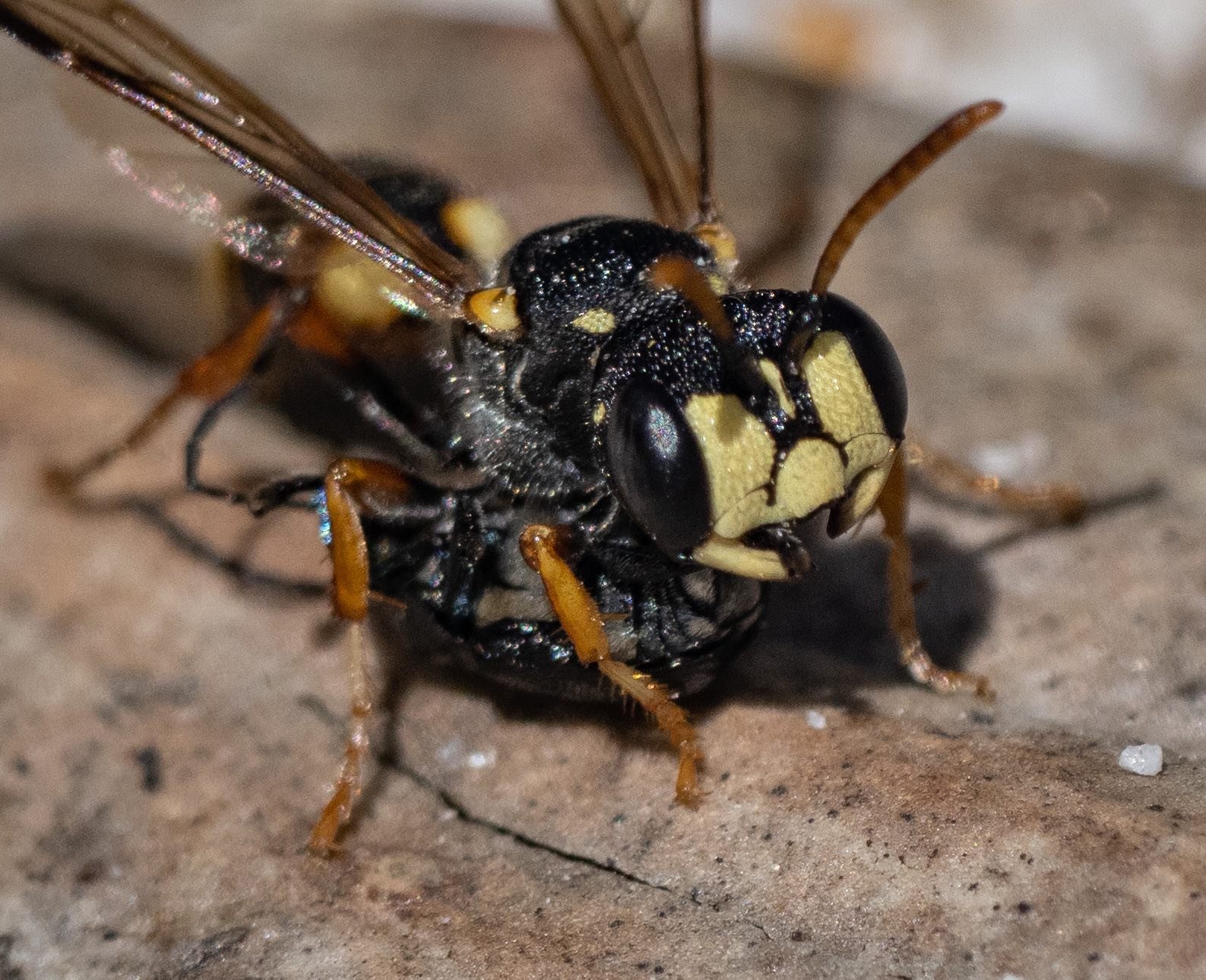
Pre-season: searching
A very early season sighting … our earliest, by far. This female would have spent the winter underground, and is now looking for a site to start a new burrow. The patch she is exploring is amid an active nesting aggregation of Rhopalum (Crabroninae), not far from our known Cerceris nesting site.
11 September, 2022
Cerceris antipodes

Early season: and already 7 months old
This female has been been actively nesting for over a month, having mated last Autumn and then overwintering below ground. Her mandibles are looking worn but she will probably continue to nest for many weeks to come.
20 November, 2022
Cerceris antipodes

Early season: providing for the next generation
Until late November, the only wasps in evidence are females. Leaf beetles are their principal prey.
24 November, 2022
Cerceris antipodes

Peak season: a very worn female
When females return with prey, they usually dive straight into their open burrow. But occasionally one will land, briefly. Perhaps she lost her bearings. Or maybe she needs to adjust her grip. She is ageing, her mandibles clearly worn. And she relies on them to hold the beetle’s antennae. Based on the obvious wear, and the date, she’s either of generation O (i.e. overwintering) or a very early 1st generation female.
2 February, 2023
Cerceris antipodes

Peak season: another showing her age
Over time, females start to show the ravages of a life spent digging and hunting. The mandibles wear, the teeth and tips becoming blunt. And the wings become ragged as they collect small tears along the trailing edges. This female is probably several months old. She will die before May.
19 February, 2023
Cerceris antipodes

Late season: just a few days into adult life
A young female, probably yet to mate, and sure to overwinter. The silvery hairs on her face and the pointed mandibles are evidence of her youth … as is the date, and the fact that she was attracting a lot of male attention (see next photo)!
21 April, 2023
Cerceris antipodes

Late season: male seeking to mate
For at least 15 minutes he hung about, waiting for a chance to mate with the young female. She would occasionally poke her head out (see previous photo) but mostly she remained tucked away inside, with just her antennae showing (green arrow).
21 April, 2023
Cerceris antipodes

1. Burrow entrance choked with traffic
This is what captured my attention … a pair of bodies jammed into the entrance of the burrow, wriggling and kicking but not breaking free.
23 March, 2023
Cerceris antipodes

6. The first female disappears
Finally, after several minutes at the burrow entrance, the first female disappears. She may have simply been stuck, jammed against the wall by the male. More likely, he was restraining her by gripping her thorax with his legs or mandibles.

7. The male hauls himself back up
He seems reluctant to continue into the now-open burrow, backing out as the second female looks on.

8. Finally, she scurries inside
As the male moves aside, the second female quickly heads into the burrow. Successfully. A moment after this photo, she had disappeared into the nest.

Provisioning
A female approaches her burrow after a successful hunting trip, carrying a deeply paralysed beetle.
18 March, 2023
Cerceris antipodes

Guard duty
The typical view of an active Cerceris nest … the burrow entrance blocked by the broad head of a female on guard duty.
28 February, 2023
Cerceris antipodes

Returning empty-handed
This female is about to dive into her open burrow. It’s likely she is not on hunting duty today, but rather has simply been visiting flowers for a feed of nectar.
24 November, 2022
Cerceris antipodes

Protection from raiding ants
This ant quickly moved away, no doubt deterred by the large mandibles of the wasp on guard duty, blocking the burrow.
24 November, 2022
Cerceris antipodes

Nest collapse
Rarely a provisioning female returns to find her burrow collapsed. The cause might be a strong wind, fossicking bird, or passing mammal (but not me … I’m careful where I step). This female spent several minutes trying to reopen her burrow. She eventually gave up, abandoning her prey and flying off to rest on nearby vegetation. It was early in the season and I suspect she was nesting solo. If there had been a nestmate inside, they would have cleared the entryway from within. Another potential advantage of having a guard on duty.
10 November, 2022
Cerceris antipodes
















